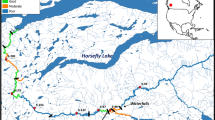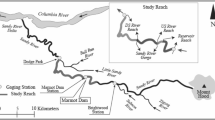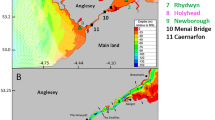Abstract
The estuarine turbidity maximum (ETM) is an important nursery area for anadromous fish where early-life stages can be retained in high prey concentrations and favorable salinities. Episodic freshwater flow and wind events could influence the transport of striped bass (Morone saxatilis) eggs to the ETM. This hypothesis was evaluated with regression analysis of observational data and with a coupled biological-physical model of a semi-idealized upper Chesapeake Bay driven by observed wind and freshwater flow. A particle-tracking model was constructed within a numerical circulation model (Princeton Ocean Model) to simulate the transport of fish eggs in a 3-dimensional flow field. Particles with the sinking speed of striped bass eggs were released up-estuary of the salt front in both 2-d event-scale and 60-d seasonal-scale scenarios. In event scenarios, egg-like particles with observed specific gravities (densities) of striped bass eggs were transported to the optimum ETM nursery area after 2 d, the striped bass egg-stage duration. Wind events and pulses in river discharge decreased the number of egg-like particles transported to the ETM area by 20.9% and 13.2%, respectively, compared to nonevent conditions. In seasonal scenarios, particle delivery to the ETM depended upon the timing of the release of egg-like particles. The number of particles transported to the ETM area decreased when particles were released before and during wind and river pulse events. Particle delivery to the ETM area was enhanced when the salt front was moving up-estuary after river pulse events and as base river flow receded over the spawning season. Model results suggest that the timing of striped bass spawning in relation to pulsed events may have a negative (before or during events) or positive (after river flow events) effect on egg transport. Spawning after river flow events may promote early-stage survival by taking advantage of improved transport, enhanced turbidity refuge, and elevated prey production that may occur after river pulse events. In multiple regression analysis of observed data, mean spring freshwater flow rates and the number of pulsed freshwater flow events during the striped bass spawning season explained 71% of the variability in striped bass juvenile abundance in upper Chesapeake Bay from 1986 to 2002. Positive parameter estimates for these effects support the hypothesis that pulsed freshwater flow events, coupled with spawning after the events, may enhance striped bass early-stage survival. Results suggest that episodic events may have an important role in controlling fish recruitment.
Similar content being viewed by others
Literature Cited
Albrecht, A. B. 1964. Some observations on factors associated with survival of striped bass eggs and larvae.California Fish and Game 50:100–113.
Bartsch, J. andS. H. Coombs. 2001. An individual-based growth and transport model of the early life-history stages of mackerel (Scomber scombrus) in the eastern North Atlantic.Ecological Modelling 138:127–141.
Bennett, W. A., W. J. Kimmerer, andJ. R. Burau. 2002. Plasticity in vertical migration by native and exotic estuarine fishes in a dynamic low-salinity zone.Limnology and Oceanography 47:1496–1507.
Bergey, L. L., R. A. Rulifson, M. L. Gallagher, andA. S. Overton. 2003. Variability of Atlantic coast striped bass egg characteristics.North American Journal of Fisheries Management 23: 558–572.
Blumberg, A. F. andG. L. Mellor. 1987. A description of a three-dimensional coastal ocean circulation model, p. 1–16.In N. Heaps (ed.), Three-dimensional Coastal Ocean Models, Volume 4. American Geophysical Union, Washington, D.C.
Boynton, W. R., W. Boicourt, S. Brant, J. Hagy, L. W. Harding, E. Houde, D. V. Holliday, M. Jech, W. M. Kemp, C. Lascara, S. D. Leach, A. P. Madden, M. Roman, L. P. Sanford, and E. M. Smith. 1997. Interactions between physics and biology in the estuarine turbidity maximum (ETM) of Chesapeake Bay, USA. International Council for the Exploration of the Sea CM 1997/S:11.
Brickman, D. andP. C. Smith. 2002. Lagrangian stochastic modeling in coastal oceanography.Journal of Atmospheric and Ocean Technology 19:83–99.
Brown, C. A., S. A. Holt, G. A. Jackson, D. A. Brooks, andG. J. Holt. 2004. Simulating larval supply to estuarine nursery areas: How important are physical processes to the supply of larvae to the Aransas Pass Inlet?Fisheries Oceanography 13:181–196.
Chao, S.-Y. 1987. Wind-driven motion near inner-shelf fronts.Journal of Geophysical Research 92:3849–3860.
Chao, S. Y. 1988. River-forced estuarine plumes.Journal of Physical Oceanography 18:72–88.
Chesney, E. J. 1989. Estimating the food-requirements of striped bass larvaeMorone saxatilis—Effects of light, turbidity and turbulence.Marine Ecology Progress Series 53:191–200.
Cushing, D. 1975. Marine Ecology and Fisheries, 1st edition. Cambridge University Press, Cambridge, U.K.
Dauvin, J. C. andJ. J. Dodson. 1990. Relationship between feeding incidence and vertical and longitudinal distribution of rainbow smelt larvae (Osmerus morlax) in a turbid well-mixed estuary.Marine Ecology Progress Series 60:1–12.
Dodson, J. J., J. C. Dauvin, R. G. Ingram, andB. Dangeljan. 1989. Abundance of larval rainbow smelt (Osmerus mordax) in relation to the maximum turbidity zone and associated macroplanktonic fauna of the middle St. Lawrence estuary.Estuaries 12:66–81.
Doroshev, S. I. 1970. Biological features of the eggs, larvae, and young of the striped bass (Roccus saxatilis (Walbaum)) in connection with the problem of its acclimatization in the USSR.Journal of Ichthyology 10:235–248.
Dovel, W. L. 1971. Fish eggs and larvae of the upper Chesapeake Bay. University of Maryland, NRI Special Report No. 4. Solomons, Maryland.
Geyer, W. R. andR. P. Signell. 1992. A reassessment of the role of tidal dispersion in estuaries and bays.Estuaries 15:97–108.
Govoni, J. J. andL. J. Pietrafesa. 1994. Eulerian views of layered water currents, vertical distributions of some larval fishes, and inferred advective transport over the continental shelf off North Carolina, USA, in winter.Fisheries Oceanography 3:120–132.
Hall, L. W., A. E. Pinkney, L. O. Horseman, andS. E. Finger. 1985. Morality of striped bass larvae in relation to contaminants and water-quality in a Chesapeake Bay tributary.Transactions of the American Fisheries Society 114:861–868.
Hare, J. A., J. A. Quinlan, F. E. Werner, B. O. Blanton, J. J. Govoni, R. B. Forward, L. R. Settle, andD. E. Hoss. 1999. Larval transport during winter in the SABRE study area: Results of a coupled vertical behaviour-three-dimensional circulation model.Fisheries Oceanography 8:57–76.
Heath, M. R. andA. Gallego. 1998. Bio-physical modelling of the early life stages of haddock,Melanogrammus aeglefinus, in the North Sea.Fisheries Oceanography 7:110–125.
Hinckley, S., A. J. Hermann, K. L. Mier, andB. A. Megrey. 2001. Importance of spawning location and timing to successful transport to nursery areas: A simulation study of Gulf of Alaska walleye pollock.ICES Journal of Marine Science 58: 1042–1052.
Hinrichsen, H. H., U. Bottcher, F. W. Koster, A. Lehmann, andM. A. St. John. 2003. Modelling the influences of atmospheric forcing conditions on Baltic cod early life stages: Distribution and drift.Journal of Sea Research 49:187–201.
Iles, T. D. andM. Sinclair. 1982. Atlantic herring: Stock discreteness and abundance.Science 215:267–633.
Jassby, A. D., W. J. Kimmerer, S. G. Monismith, C. Armor, J. E. Cloern, T. M. Powell, J. R. Schubel, andT. J. Vendlinski. 1995. Isohaline position as a habitat indicator for estuarine populations.Ecological Applications, 5:272–289.
Kane, A. S., R. O. Bennett, andE. B. May. 1990. Effect of hardness and salinity on survival of striped bass larvae.North American Journal of Fisheries Management 10:67–71.
Kimmel, D. G. andM. R. Roman. 2004. Long-term trends in mesozooplankton abundance and community composition in the Chesapeake Bay: Influence of freshwater input.Marine Ecology Progress Series 267:71–83.
Kimmerer, W. J., J. R. Burau, andW. A. Bennett. 1998. Tidally oriented vertical migration and position maintenance of zooplankton in a temperate estuary.Limnology and Oceanography 43:1697–1709.
Lal, K., R. Lasker, andA. Kuljis. 1977. Acclimation and rearing of striped bass larvae in sea water.California Fish and Game 63: 210–218.
Laprise, R. andJ. J. Dodson. 1989. Ontogenetic changes in the longitudinal distribution of two species of larval fish in a turbid well-mixed estuary.Journal of Fish Biology 35:39–47.
Lasker, R. 1975. Field criteria for survival of anchovy larvae: The relation between inshore chlorophyll maximum layers and successful first feeding.Fishery Bulletin, 73:453–462.
Mansueti, R. J. 1958. Eggs, larvae, and young of the striped bass,Roccus saxatilis. Maryland Department of Research and Education, Chesapeake Biological Laboratory, Solomons, Maryland.
McGovern, J. C. andJ. E. Olney. 1996. Factors affecting survival of early life stages and subsequent recruitment of striped bass on the Pamunkey River, Virginia.Canadian Journal of Fisheries and Aquatic Sciences 53:1713–1726.
Mellor, G. L. 1998. User's guide for a three-dimensional, primitive equation, numerical ocean model, p. 44. Program in Atmospheric and Ocean Sciences, Princeton University, Princeton, New Jersey.
Mellor, G. L. andT. Yamada. 1974. A hierarchy of turbulence closure models for planetary boundary layers.Journal of Atmospheric Science 31:1791–1806.
Morgan, R. P., V. J. Rasin, andR. L. Copp. 1981. Temperature and salinity effects on development of striped bass eggs and larvae.Transactions of the American Fisheries Society 110:95–99.
North, E. W., S.-Y. Chao, L. P. Sanford, andR. R. Hood. 2004. The influence of wind and river pulses on an estuarine turbidity maximum: Numerical studies and field observations in Chesapeake Bay.Estuaries 27:132–146.
North, E. W. andE. D. Houde. 2001. Retention of white perch and striped bass larvae: Biological-physical interactions in Chesapeake Bay estuarine turbidity maximum.Estuaries 24: 756–769.
North, E. W. andE. D. Houde. 2003. Linking ETM physics, zooplankton prey, and fish early-life histories to white perch (Morone americana) and striped bass (M. saxatilis) recruitment success.Marine Ecology Progress Series 260:219–236.
North, E. W. andE. D. Houde. 2004. Distribution and transport of bay anchovy (Anchoa mitchilli) eggs and larvae in Chesapeake Bay.Estuarine Coastal and Shelf Science 60:409–429.
Olney, J. E., J. D. Field, andJ. C. McGovern. 1991. Striped bass egg mortality, production, and female biomass in Virginia rivers, 1980–1989.Transactions of the American Fisheries Society 120:354–367.
Raudkivi, A. J. 1990. Loose Boundary Hydraulics, 3rd edition. Pergamon Press, Oxford, U.K.
Robichaud-LeBlanc, K. A., S. C. Courtenay, andA. Locke. 1996. Spawning and early life history of a northern population of striped bass (Morone saxatilis) in the Miramichi River estuary, Gulf of St. Lawrence.Canadian Journal of Zoology 74: 1645–1655.
Roman, M. R., D. V. Holliday, andL. P. Sanford. 2001. Temporal and spatial patterns of zooplankton in the Chesapeake Bay turbidity maximum.Marine Ecology Progress Series 213:215–227.
Rothschild, B. J. andT. R. Osborn. 1988. Small-scale turbulence and plankton contact rates.Journal of Plankton Research 10:465–474.
Rulifson, R. A. andK. A. Tull. 1999. Striped bass spawning in a tidal bore river: The Shubenacadie estuary, Atlantic Canada.Transactions of the American Fisheries Society 128:613–624.
Rutherford, E. S. andE. D. Houde. 1995. The influence of temperature on cohort-specific growth, survival, and recruitment of striped bass,Morone saxatilis, larvae in Chesapeake Bay.Fishery Bulletin 93:315–332.
Rutherford, E. S., E. D. Houde, andR. M. Nyman. 1997. Relationship of larval-stage growth and mortality to recruitment of striped bass,Morone saxatilis, in Chesapeake Bay.Estuaries 20:174–198.
Sanford, L. P., W. C. Boicourt, andS. R. Rives. 1992. Model for estimating tidal flushing of small embayments.Journal of Waterway Port Coastal and Ocean Engineering-ASCE 118:635–654.
Sanford, L. P., S. E. Suttles, andJ. P. Halka. 2001. Reconsidering the physics of the Chesapeake Bay estuarine turbidity maximum.Estuaries 24:655–669.
SAS Institute Inc. 1997. SAS/STAT Sofware: Changes and Enhancements through Release 6.12. Cary, North Carolina.
Schiller, L. and A. Naumann. 1993. Über die grundlegenden Berechnungen bei der Schwerkraftaufbereitung. Zeitschrift d. V.D.I. 77.
Schubel, J. R. 1968. Turbidity maximum of northern Chesapeake Bay.Science 161:1013–1015.
Schubel, J. R., W. Cronin, andG. Schmidt. 1974. Some observations on the sizes and settling velocities of fish eggs. The Johns Hopkins University, Chesapeake Bay Institute. Baltimore, Maryland.
Schubel, J. R. andD. W. Pritchard. 1986. Responses of upper Chesapeake Bay to variations in discharge of the Susquehanna River.Estuaries 9:236–249.
Secor, D. H. 2000. Spawning in the nick of time? Effect of adult demographics on spawning behavior and recruitment in Chesapeake Bay striped bass.ICES Journal of Marine Science 57: 403–411.
Secor, D. H. andE. D. Houde. 1995. Temperature effects on the timing of striped bass egg-production, larval viability, and recruitment potential in the Patuxent River (Chesapeake Bay).Estuaries 18:527–544.
Secor, D. H., E. D. Houde, andD. M. Monteleone. 1995. A mark-release experiment on larval striped bassMorone saxatilis in a Chesapeake Bay tributary.ICES Journal of Marine Science 52:87–101.
Setzler-Hamilton, E. M., W. R. Boynton, J. A. Mihursky, T. T. Polgar, andK. V. Wood. 1981 Spatial and temporal distribution of striped bass eggs, larvae and juveniles in the Potomac estuary.Transactions of the American Fisheries Society 110: 121–136.
Setzler-Hamilton, E. M. andL. Hall, Jr. 1991. Striped bass,Morone saxatilis, p. 13-11–13-31.In S. L. Funderburk, S. J. Jordan, J. A. Mihursky, and D. Riley (eds.), Habitat Requirements for Chesapeake Bay Living Resources. Chesapeake Bay Program, Annapolis, Maryland.
Simenstad, C. A., C. A. Morgan, J. R. Cordell, andJ. A. Baross. 1994. Flux, passive retention and active residence of zooplankton in Columbia River estuarine turbidity maxima, p. 473–482.In K. R. Dyer and R. J. Orth (eds.), Changes in Fluxes in Estuaries: Implications from science to management. Olsen and Olsen, Fredensborg, Denmark.
Sirois, P. andJ. J. Dodson. 2000. Critical periods and growth-dependent survival of larvae of an estuarine fish, the rainbow smeltOsmerus mordax.Marine Ecology Progress Series 203:233–245.
Uphoff, J. H. 1989. Environmental effects on survival of eggs, larvae, and juveniles of striped bass in the Choptank River, Maryland.Transactions of the American Fisheries Society 118:251–263.
Visser, A. W. 1997. Using random walk models to simulate the vertical distribution of particles in a turbulent water column.Marine Ecology Progress Series 158:275–281.
Waldman, J. R., K. Nolan, J. Hart, andI. I. Wirgin. 1996. Genetic differentiation of three key anadromous fish populations of the Hudson River.Estuaries 19:759–768.
Werner, F. E., B. R. MacKenzie, R. I. Perry, R. G. Lough, C. E. Naimie, B. O. Blanton, andJ. A. Quinlan. 2001. Larval trophodynamics, turbulence, and drift on Georges Bank: A sensitivity analysis of cod and haddock.Scientia Marina 65:99–115.
Werner, F. E., R. I. Perry, R. G. Lough, andC. E. Naimie. 1996. Trophodynamic and advective influences on Georges Bank larval cod and haddock.Deep-Sea Research 43:1793–1822.
Winger, P. V. andP. J. Lasier. 1994. Effects of salinity on striped bass eggs and larvae from the Savannah River, Georgia.Transactions of the American Fisheries Society 123:904–912.
Winkler, G., J. J. Dodson, N. Bertrand, D. Thivierge, andW. F. Vincent. 2003. Trophic coupling across the St. Lawrence River estuarine transition zone.Marine Ecology Progress Series 251:59–73.
Author information
Authors and Affiliations
Corresponding author
Rights and permissions
About this article
Cite this article
North, E.W., Hood, R.R., Chao, S.Y. et al. The influence of episodic events on transport of striped bass eggs to the estuarine turbidity maximum nursery area. Estuaries 28, 108–123 (2005). https://doi.org/10.1007/BF02732758
Received:
Accepted:
Issue Date:
DOI: https://doi.org/10.1007/BF02732758




